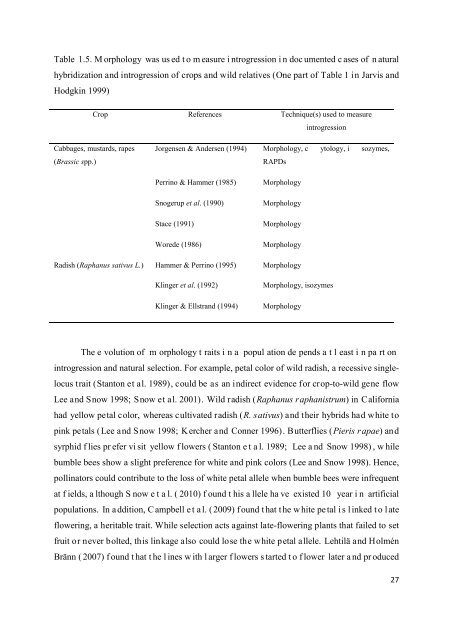UNIVERSITE DE BOURGOGNE THÈSE Yongbo LIU - Université de ...
UNIVERSITE DE BOURGOGNE THÈSE Yongbo LIU - Université de ...
UNIVERSITE DE BOURGOGNE THÈSE Yongbo LIU - Université de ...
You also want an ePaper? Increase the reach of your titles
YUMPU automatically turns print PDFs into web optimized ePapers that Google loves.
Table 1.5. M orphology was us ed t o m easure i ntrogression i n doc umented c ases of n atural<br />
hybridization and introgression of crops and wild relatives (One part of Table 1 in Jarvis and<br />
Hodgkin 1999)<br />
Crop References Technique(s) used to measure<br />
introgression<br />
Cabbages, mustards, rapes<br />
(Brassic spp.)<br />
Jorgensen & An<strong>de</strong>rsen (1994) Morphology, c<br />
RAPDs<br />
ytology, i sozymes,<br />
Perrino & Hammer (1985) Morphology<br />
Snogerup et al. (1990) Morphology<br />
Stace (1991) Morphology<br />
Wore<strong>de</strong> (1986) Morphology<br />
Radish (Raphanus sativus L.) Hammer & Perrino (1995) Morphology<br />
Klinger et al. (1992) Morphology, isozymes<br />
Klinger & Ellstrand (1994) Morphology<br />
The e volution of m orphology t raits i n a popul ation <strong>de</strong> pends a t l east i n pa rt on<br />
introgression and natural selection. For example, petal color of wild radish, a recessive singlelocus<br />
trait (Stanton et al. 1989), could be as an indirect evi<strong>de</strong>nce for crop-to-wild gene flow<br />
Lee and Snow 1998; Snow et al. 2001). Wild radish (Raphanus raphanistrum) in California<br />
had yellow petal color, whereas cultivated radish (R. sativus) and their hybrids had white to<br />
pink petals (Lee and Snow 1998; Kercher and Conner 1996). Butterflies (Pieris rapae) and<br />
syrphid f lies pr efer vi sit yellow f lowers ( Stanton e t a l. 1989; Lee a nd Snow 1998) , w hile<br />
bumble bees show a slight preference for white and pink colors (Lee and Snow 1998). Hence,<br />
pollinators could contribute to the loss of white petal allele when bumble bees were infrequent<br />
at f ields, a lthough S now e t a l. ( 2010) f ound t his a llele ha ve existed 10 year i n artificial<br />
populations. In a ddition, C ampbell e t a l. ( 2009) f ound t hat t he w hite pe tal i s l inked t o l ate<br />
flowering, a heritable trait. While selection acts against late-flowering plants that failed to set<br />
fruit or never bolted, this linkage also could lose the white petal allele. Lehtilä and Holmén<br />
Bränn ( 2007) f ound t hat t he l ines w ith l arger f lowers s tarted t o f lower later a nd pr oduced<br />
27
















